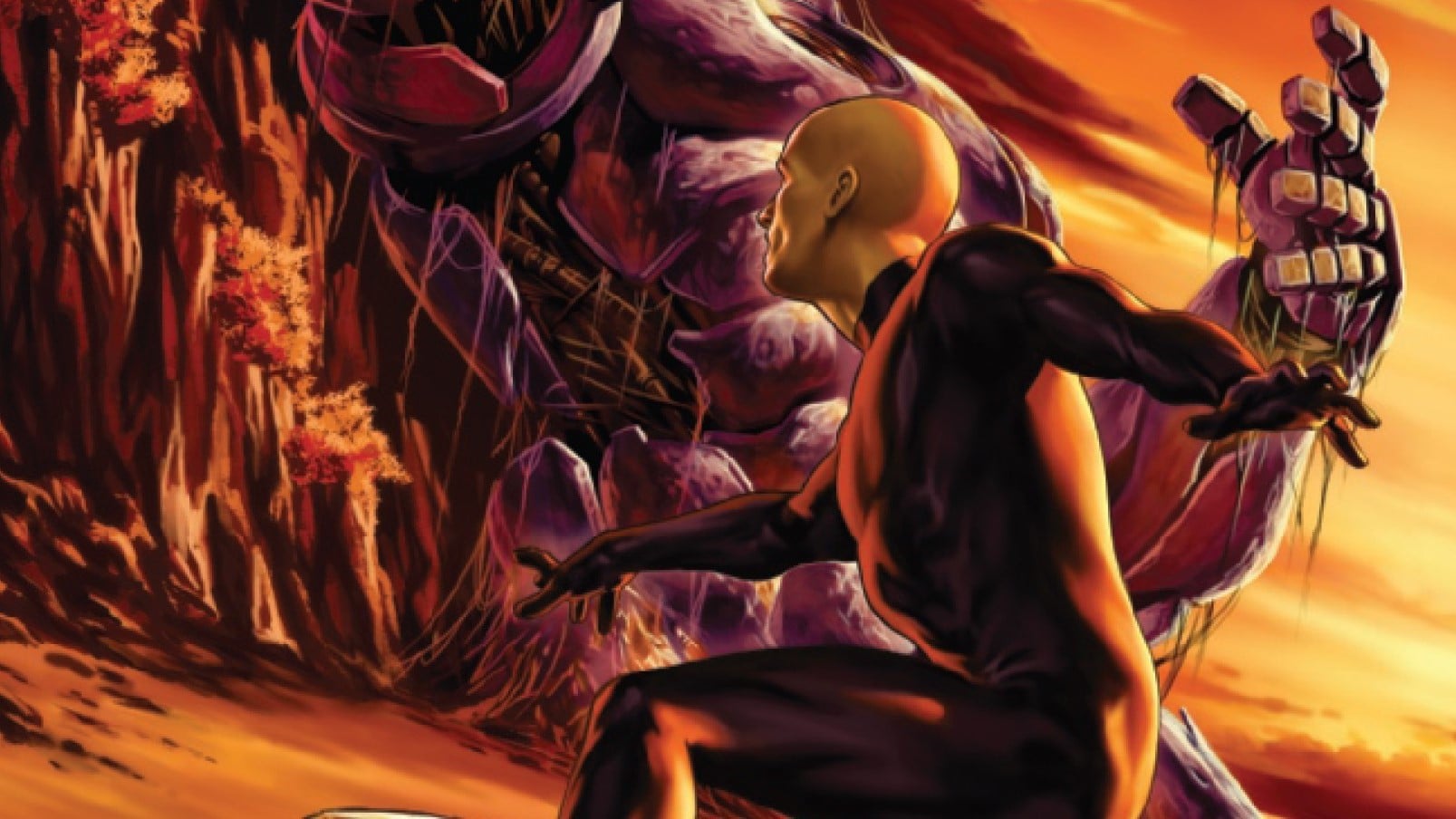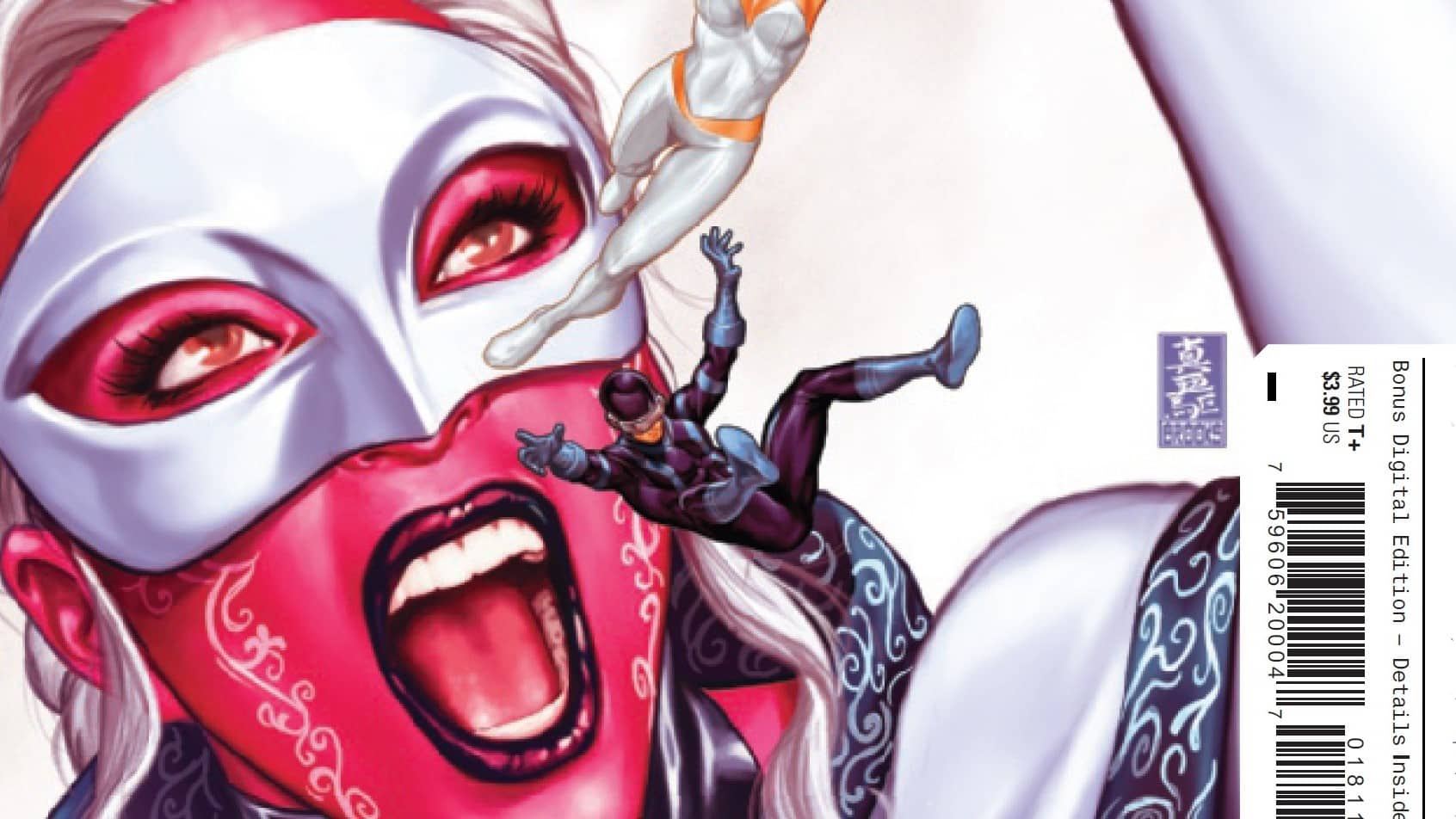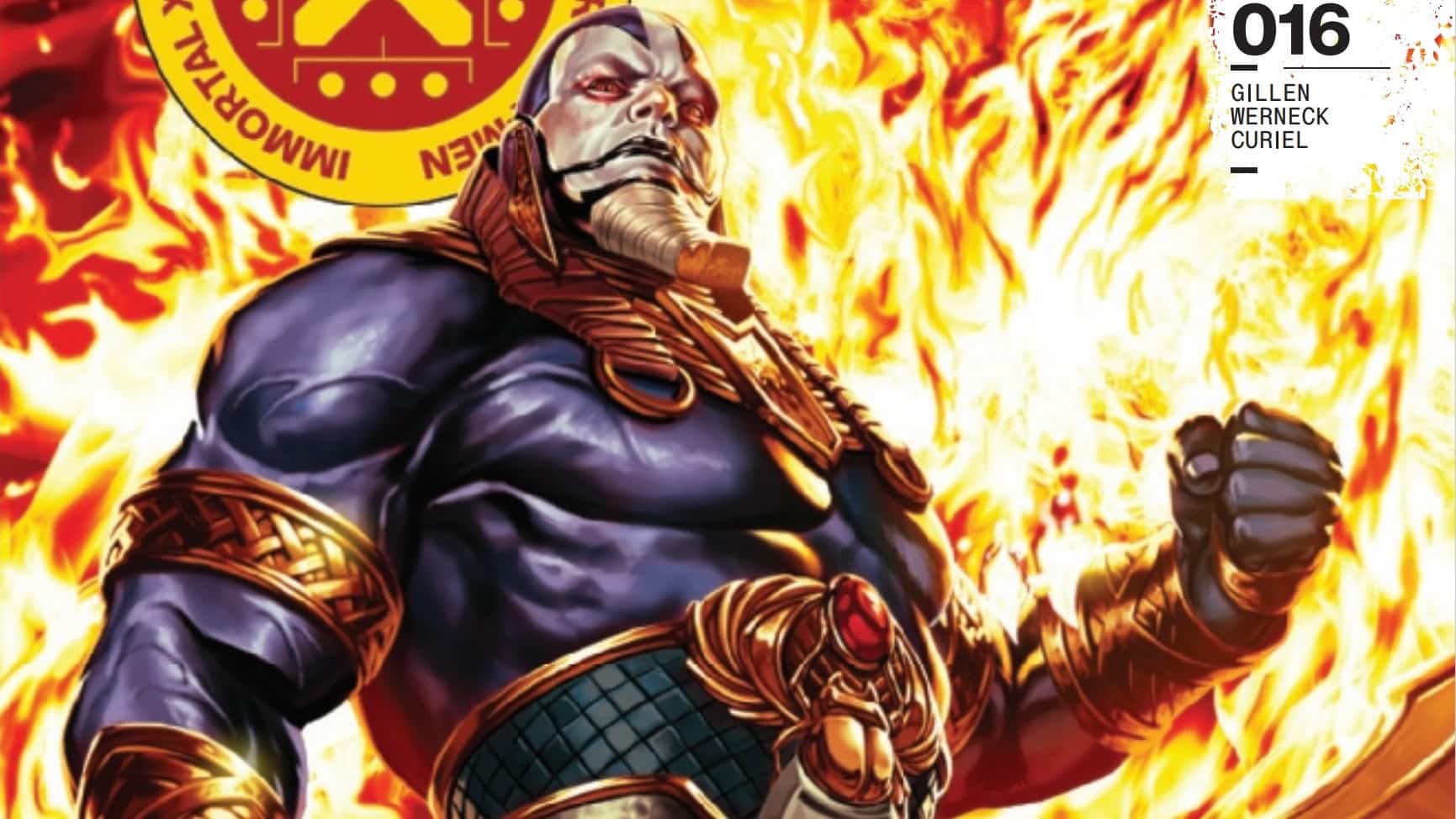“We maniacs! We blew it up! Oh, damn us! Goddamn us all to Hell!” So says Professor Charles Xavier in Immortal X-Men #14, written by Kieron Gillen, drawn by Lucas Werneck, colored by David Curiel and Erick Arciniega, and lettered by Clayton Cowles.
Mark: Hey, so I was away for last month’s issue. … Did I miss anything important?
Austin: Eh, not really. I mean, Storm and Exodus got into a fight, Doug convinced the Quiet Council to disband then got thrown into the Pit by Krakoa for his own protection, which led to Destiny suddenly losing track of the future, but on the scale of “you have new gods” and “the X-Men are obliterated by a bubblegum robut,” you know, a solid 5.
Mark: It’s funny: We chatted privately last week about fandom deciding which comics “count” or “matter” in the grand scheme of things (Joke’s on us, though: None of them “matter,” they’re comics). And it seems like the big developments in last month’s Immortal X-Men that would have reverberations throughout the line (i.e., how much the issue “matters”) would be the dissolution of the Quiet Council and The Five going on strike. And then the Hellfire Gala issue happened, and it turns out those things? They don’t really matter. There’s no Krakoan society to govern, and four of The Five are missing.
So, shall we check out what “counts” moving forward into this brave new status quo, with the former Quiet Council members blown to the four winds?
Dusk of X
Mark: The issue opens with the sole remaining mutant on Pacific Krakoa: Professor Charles Xavier. He’s not looking too great. Bald. Unshaven. Emotionally wiped out. And tired, like he hasn’t slept in the X weeks since the gala. It’s almost as if Gillen sent Werneck photos of himself after the recent birth of his first child as a photo reference.
Austin: The first five pages of this issue largely serve as a recap of the events of the gala — at least the pieces most directly involving Xavier — and while that’s likely a necessity given that Gillen and Werneck probably can’t assume EVERYONE reading this issue also read the gala issue, they make the most of it. The image of the disheveled, dead-eyed Xavier (who doesn’t speak in these opening pages) does a lot to sell just how despondent he is (while also doing a lot to reverse the image of the cool, logical, Cerebro-helmeted Xavier who somehow always seemed in control even when he wasn’t in the previous issues of this series). The layouts, meanwhile, invoke the iconic Moira reveal of House of X #2, depicting events via a series of rectangular landscape panels intercutting closeups of Xavier’s face with more vivid, intense images. It helps sell just how far things have fallen since those heady HoXPoX days.
Mark: There’s also a very interesting use of the passage of time here. It opens with the sun just peaking over the horizon: could be dawn, could be dusk. We don’t know which direction Xavier is facing. As we focus on his face (always centered in the panel), we see a dragonfly pass behind him. It takes two pages of flashbacks for the dragonfly to make it from one end of the panel to the other. So while Xavier’s mind is racing in his PTSD flashback, very little actual time is passing. Each moment of Xavier’s life right now seems to take an eternity. And he’s been there for weeks. The sequence ends with the sun slightly lower on the horizon than it was on the second page (as you can see).
It’s dusk, the sun is setting on Krakoa. What was the era called right after HoXPoX again?
Austin: Oh god, does that mean the return of vampires for “Twilight of X” is on the horizon?
Seriously though, great observation! Xavier spends most of this in a shell-shocked state, though we get a few variations on it later on. One is when he’s contacted telepathically by Emma, which underscores just how broken he is, as he refuses to believe the mutants he led into the gates aren’t dead. Then we see that he is taking some action, using his telepathy to scare off Sebastian Shaw’s goons (more on that below), in order to preserve Krakoa as a kind of mutant memorial.
In doing so, it shows a more militant side of Xavier — he is, at this point, only creating telepathic images of monsters to run off the goons, but he also says he’d “rather the air was torn from their lungs than they smell the flowers growing on this mutant grave,” which has a very … classical Magneto vibe to it. Last issue addressed the way Xavier squared the circle of his integrationist dream with the more separatist nation of Krakoa; are we seeing the point at which he abandons the dream fully and becomes a darker kind of mutant?
Mark: There’s another thing we should be thinking about here, with Xavier as the only mutant on the island, and it’s something that gets mentioned in Shaw’s data page: Krakoa needs to feed. It needs to consume about one person per month, so is Xavier conscious of this? Is he letting himself be consumed as penance?
I don’t know if we’re meant to take the everpresent “X weeks later” that’s been popping up in these early “Fall of X” books as meaning “10 weeks later,” but I view it as “unknown weeks later.” Ten weeks seems a long time for some of the things we’ve been seeing, and it would mean Charley’s been on the island for more than two months and hasn’t been consumed yet.
Austin: The other allusion being threaded through all this is the Scarlet Witch and the last/biggest mutant extinction event, Decimation. The title of Immortal X-Men #14 is “Sympathy for the Scarlet Witch,” which given the ostensible focus on Xavier, suggests Xavier is putting himself in a similar role, as the agent of mass mutant extinction. We also see him echo the phrase “no more” following his Magneto-esque diatribe, both invoking Scarlet’s Witch mutant-eradicating spell and adding more ominous vibes to his mindset.
Mark: It’s also clearly a pun on “Sympathy for the Devil,” since, as we saw way back in Jonathan Hickman and Leinil Yu’s X-Men #7 (one of the more unsettling issues of the “Dawn of X”), Exodus was teaching the young mutants of Krakoa that Wanda was basically their version of the devil. But also, as our colleague Corey pointed out in our Slack, the book also has a magic lady associated with the color red in Mother Righteous, so the title might sneakily also apply to her as well.
‘Never really a mutant’

Austin: Sebastian Shaw was noticeably absent from the Hellfire Gala, and this issue confirms what was largely already established: Shaw has sold out mutants in his pursuit of personal wealth and power, throwing in with Orchis and helping them orchestrate their attack on Krakoa in exchange for what he thought was the wealth of Krakoa.
Mark: The walking indictment of capitalism that is Sebastian Shaw continues to deliver the hits, such as, “I’m not a bloody supervillain, for @#&%$ sake. I’m a businessman.” And his nullifying of his X-gene early on in the issue, while averring that “I was never really a mutant. I just had a mutant gene” puts one in mind of any number of people from oppressed groups who ultimately sided with their oppressors. He’s eager to place himself above the other mutants, to position himself as one of the “good” ones. But you just know that the moment he does something Orchis doesn’t like, he’ll be the first against the wall, and he won’t have his mutant gift to absorb and redirect the power of the bullet.
Austin: While Shaw doesn’t fall quite that far in this issue, he’s well on his way toward it over the course of just a few pages: He learns he only has access to Krakoa (the island), not its financial infrastructure, he’s ousted from the Hellfire Club by its new White King, Wilson Fisk, and finds himself unable to exploit what resources he can glean from his ownership of the island by Xavier’s telepathic “do not disturb” sign. At one point Emma shows up to admonish him, and he does his best to meet her taunts with bravado, but it’s clear the deal isn’t working out the way he expected.
Mark: He even tries to guilt Emma by telling her that her presence will get people killed, as if he remotely cares about such things.
From our final set of council members, we’ve got Xavier, Shaw, Hope, Destiny, Emma, Exodus and Selene all showing up in this issue. Kate’s off in X-Men, doing murders, Storm is still a major player in X-Men Red, Nightcrawler is getting his own solo, and Mystique is presumed dead. That leaves Colossus as something of an … X factor, if you’ll excuse the term. For the aftermath of a big kill-off of major characters, the cast of this book mostly remain going concerns.
Austin: It’s an interesting narrative … bait-and-switch has perhaps more unintended negative connotations, but seems apt, that Gillen has pulled off. He blew up the Quiet Council in his book about the Quiet Council, right before … pretty much everything else got blown up. So now, almost by default, he still gets to play with that same cast despite having removed their reason for being featured in this series. And, because the Quiet Council was mostly made up of major mutant power players (and Colossus) by design, the events of “Fall of X” still keep them on the board, to some extent. All of which gets back to that initial discussion of what “matters” — the dissolution of the council felt like a big deal, until the Hellfire Gala outdid it. Yet perhaps the two working in concert give more “impact” to the whole than the respective parts, which is ultimately what we want out of our shared-universe ongoing serial adventure stories.
Mark: And no votes!
Bemidbar

Austin: Finally, in what serves as essentially a coda to the entire issue, we get a brief check-in with a few more former council members in the form of Exodus, Hope and Destiny, who are stranded in a desert described as “nowhere, no-when” along with a city’s-worth of mutants (presumably the ones on Krakoa during the gala forced through the gates by Xavier) with no “useful” powers. They’re short on supplies, heavy on useless formalwear, and Destiny is freaking out about Mystique and an inability to see the future. Now, I’m no religious scholar, but this whole sequence sure seems rife with various allegories, right?
Mark: Oh yes, it’s the setup for the latter chapters of Shemot, the Torah book which details the tribes of Israel’s slavery in Egypt and their escape, culminating in Moses receiving the Law from God. Or, if you’re Greek, you’d call that book Exodus. The 40 years of wandering in the desert before arriving at the Promised Land of Canaan come later in Bemidbar (“In The Desert”)/Numbers. Since Torah books are given the titles of the first word in the book, the name “Shemot” means “names,” as in “Now these are the names of the children of Israel.” Israel, in this case, isn’t the modern nation, but the name given to the patriarch Jacob. Wanna guess how many children he had?
Austin: Even if I wasn’t already familiar with the Twelve Tribes of Israel, I have a feeling where this is going …
Mark: It’s twelve! Our magic number in this series about the Quiet Council. But of course, only three of the Quiet Council are in this desert. The rest are in metaphorical deserts of their own. Exodus knows this story well, and he’s cast himself in the role of Moses. But you wanna know something about Moses? He does not survive the trip. Are we being set up with a heroic self-sacrifice from a (former) supervillain?
Austin: I do love how, while everyone else is freaking out, Exodus is all, “Persecuted minority? Wandering a desert? Short on everything but faith? Now it’s Exodus’ time to shine!” He’s even got the sun glinting off his halo-ish headpiece as he rallies his followers.
But following his allusions through to the obvious Moses parallel is telling — and to your point, ominous. If Krakoa was the promised land and some renewed form of it the overarching goal for mutants in the wake of “Fall of X,” Exodus will need to be careful not to end up on the outside looking in.
Mark: And I’ll make a further prediction here: Usually, when Mutants don’t have “useful” powers, it means they’re not useful in combat. Who knows what might come in handy in the desert? What untapped mutant potential or circuits are just waiting among these teeming masses, especially with Hope there to strengthen them? There is a lot of potential in this part of the story, and I’m hoping we get to explore it.
X-Traneous thoughts
- Great Planet of the Apes homage with this issue’s cover.
- In other “mutant extinction event” allusions, Xavier alone on the island home of dead mutants recalls Emma and Genosha from “E is for Extinction,” the beginning of Grant Morrison’s X-Men run.
- Shaw referring to his aide as “New Tessa” is a delightful bit of jerkiness.
- Shaw removes his mutant gene via an injection from a device that is the spitting image of the power neutralizer Forge created and was used to rob Storm of her powers back in Uncanny X-Men #185.
- If it ain’t broke, don’t fix it.
- In the opening pages, as Xavier is flashing back to the events of the gala, we see that shortly before all hell broke loose, Destiny urged Xavier to protect Mystique at all costs. Was this just Destiny doing her best to protect her wife, or a nod that Mystique has a key role to play in mutants’ counterstrike?
- Any guesses as to which desert and on what planet Exodus and the others are on? Presumably not Earth, and not Arrako. Some kind of mystical realm created by Mother Righteous?
- Some mystical realm created by some other red-themed witch-lady?






